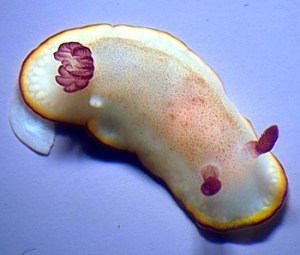
Chromodoris sinensis
Rudman, 1985
Order: NUDIBRANCHIA
Suborder: DORIDINA
Superfamily: EUDORIDOIDEA
Family: Chromodorididae
DISTRIBUTION
At present reported from Japan and China (Rudman 1985).
PHOTO
UPPER RIGHT: South Ninepin (SE), 12-14 m, July 1983, 10-14mm long preserved, AM C139272 Photo: Brian Darvell.
LOWER LEFT: Kuantan shipwreck, Malaysia, 1988. Photo: Ho Soon Lin
LOWER RIGHT: July 1984, North Ninepin (NE), 15 m. Hong Kong, AM C142942 Photo: Brian Darvell.
White with red outer and yellow inner mantle border. The white mantle is a translucent rather than an opaque white and in about half the specimens studied there can be scattering of small irregulatly shaped red specks. The gills and rhinophore clubs are translucent red, and the rhinophore stalks are white, sometimes speckle with red. It grows to approximately 30 mm in length.
This species has been recorded from Japan and China by various authors but misidentified with Chromodoris marginata (Pease), which is synonymous with C. verrieri. In Chromodoris verrieri the mantle is pigmented white whereas in C. sinensis the mantle is translucent white. In C. verrieri the gills and rhinophores are translucent and edged with white whereas in C. sinensis they are a translucent red. Most importantly the red outer colour band on the mantle is right at the edge in C. verrieri while in C. sinensis it is submarginal, there being a distinct,if narrow, marginal band of translucent white. From the many specimens available from Hong Kong it would appear that the presence of small orange-brown spots is variable, with approximately half the specimens so far collected having them.
C. sinensis is also similar in colour to C. preciosa and C. trimarginata. Both have a white outer band, then a red and then a yellow inner band to the mantle. In both cases the white outer band is of similar width to the yellow and red bands, while in C. sinensis the white band is much narrower and is translucent white rather than pigmented. In C. preciosa the rhinophore clubs and gills are translucent red with white edgings, and in C. trimarginata they are translucent clear with white edging. [I am preparing a page comparing this C. verrieri - colour group].
References:
• Rudman, W.B. (1985) The Chromodorididae (Opisthobranchia: Mollusca) of the Indo-West Pacific: Chromodoris aureomarginata, C. verrieri and C. fidelis colour groups. Zoological Journal of the Linnean Society, 83: 241-299.
• Rudman, W.B. & Darvell, B.W. (1990) Opisthobranch molluscs of Hong Kong. Part 1. Goniodorididae, Onchidorididae, Triophidae, Gymnodorididae, Chromodorididae, (Nudibranchia). Asian Marine Biology, 7: 31-79.
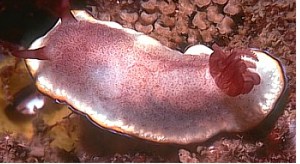
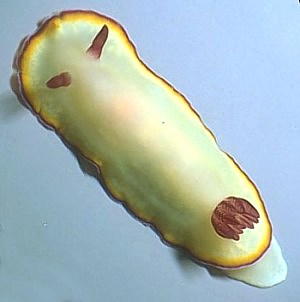
Rudman, W.B., 2000 (July 4) Chromodoris sinensis Rudman, 1985. [In] Sea Slug Forum. Australian Museum, Sydney. Available from http://www.seaslugforum.net/find/chrosine
Related messages
Chromodoris sinensis from Riau, Indonesia
June 11, 2002
From: Alice Lee
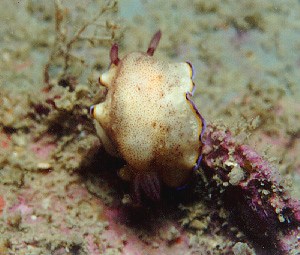
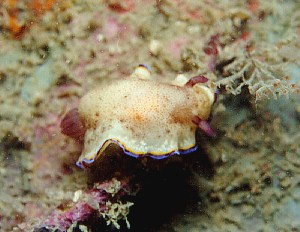
Hi, Bill,
These 2 pictures are taken on a wreck in Riau Archipelago, [Indonesia, just south of Singapore] depth 12m. Are they Chromodoris sinensis?
Regards,
Alice
alee@dlink.com.sg
Lee, A., 2002 (Jun 11) Chromodoris sinensis from Riau, Indonesia. [Message in] Sea Slug Forum. Australian Museum, Sydney. Available from http://www.seaslugforum.net/find/7158Dear Alice,
Thay do appear to be Chromodoris sinensis. This is quite interesting as it fits with the one record I mention from Malaysia in the Fact Sheet.
Best wishes,
Bill Rudman
Chromodoris sinensis from Japan
July 31, 2001
From: Nishina Masayoshi
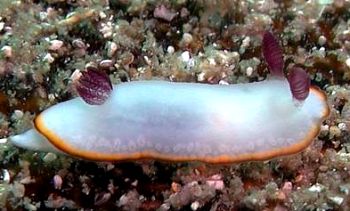
Dear Dr.Rudman,
I think this animal is Chromodoris sinensis. I found this at Echizen too. This species is rare here and at Hachijo and Sagami Bay. I have also found it once at Mable Island.
Data:
Date: 21 July, 2001
Place Echizen beach (westcost of Japan)
Depth: 8m
size: 10mm
Best Regards,
Nishina Masayoshi
nishina@hpe15.wips.co.jp
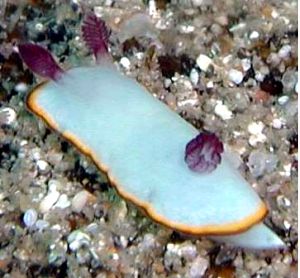
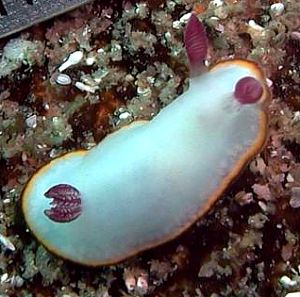
Thanks Nishina,
Yes this is C. sinensis. It would be inetsrting to know of you have ever seen the colour variery with the small red specks in Japan.
Best wishes,
Bill Rudman
Chromodoris sinensis from Hong Kong
July 19, 2001
From: Leslie Chan
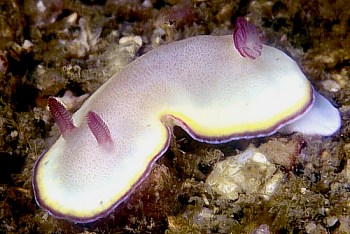
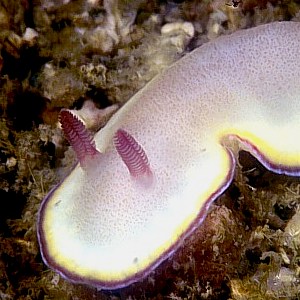
Dear Bill,
Could you identify this nudibranch which I photographed in Hong Kong.
Details: 12m, Ninepin Group, Hong Kong. 7 January 2001.
Thanks
Leslie Chan
leslie@lesmart.com
Chan, L., 2001 (Jul 19) Chromodoris sinensis from Hong Kong. [Message in] Sea Slug Forum. Australian Museum, Sydney. Available from http://www.seaslugforum.net/find/4770Dear Leslie,
This is the spotted form of Chromodoris sinensis. Your earlier photo showed an unspotted example.
Best wishes,
Bill Rudman
Chromodoris sinensis from Hong Kong
July 9, 2001
From: Leslie Chan
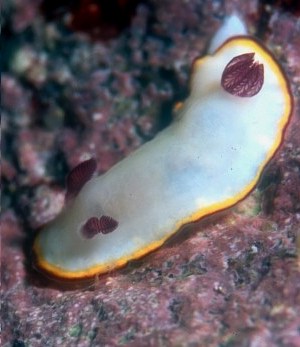
Dear Bill,
Could you identify this nudibranch which I photographed in Hong Kong.
Details: 12m, Port Island, Hong Kong. 30 September 2000.
Thanks
Leslie Chan
leslie@lesmart.com
Chan, L., 2001 (Jul 9) Chromodoris sinensis from Hong Kong. [Message in] Sea Slug Forum. Australian Museum, Sydney. Available from http://www.seaslugforum.net/find/4764Dear Leslie,
This is the colour form of Chromodoris sinensis which does not have red specks.
Best wishes,
Bill Rudman
Opisthobranchs from Hong Kong
July 21, 2000
From: Bill Rudman & Brian Darvell


In the 1980s, Brian Darvell and many willing assistants, made a large collection of opisthobranchs in Hong Kong. During this process I helped with identifications, background information and advice, and most of the collections were presented to the Australian Museum. A part of the collections were dealt with in Rudman & Darvell, (1990). To ensure that the photos and records are more widely available Brian Darvell and I have decided to add them to the Sea Slug Forum where we are able to reproduce the colour photographs much more adequately than on paper. This will of course be a gradual process, starting with the species covered in the 1990 publication.
The first species covered is Chromodoris sinensis, which falls into the Chromodoris verrieri colour group which I am also trying to complete.
PHOTOS: UPPER: South Ninepin (SE), 12-14 m, July 1983, 10-14mm long preserved, AM C139272 LOWER: July 1984, North Ninepin (NE), 15 m. Hong Kong, AM C142942 Photos: Brian Darvell.
Hong Kong Collection Records: AM C133723, 14 March 1982, Site 11.19, South Ninepin (SW), 13 m. AM C134756, 11 July 1982, Site 8.31, Kong Tau Pai (N of Wang Chan), 14 m. AM C137059-060, 2 specimens, 14 November 1982, Site 2.32, Round Is. (E), Mirs Bay, 9, 12 m. AM C138526, 2 specimens, 6 April 1983, Site 6.48, Loo Fu Fong, Tolo Channel, 3-6 m. AM C138527, 7 April 1983, Site 4.46, Kong Chau (N), Mirs Bay, 4-10 m. AM C138528, 7 April 1983, Site 7.50, Wu Kai Sha, Tolo Harbour, 0.3 m. AM C138529, 9 April 1983, Site 2.54, Mit Kok Tsui, Wong Wan Chau, Mirs Bay, 3-5 m. AM C138530, 10 April 1983, Site 4.57, Bate Head, Mirs Bay, 5-10 m. AM C138531, 3 specimens, 12 April 1983, Site 2.61, Bluff Head, Tolo Channel, 4-7 m. AM C138532, 12 April 1983, Site 6.62, Flat Reef, Tolo Channel, 7-12 m. AM C138533-534, 4 specimens, 13 April 1983, Site 5.16, Chek Chau (W), Mirs Bay, 2-5 m. AM C138535, 14 April 1983, Site 2.66, Round Is. (W), Mirs Bay, 3-6 m. AM C138536, 15 April 1983, Site 2.67, Kai Kung Tau, Kat 0 Chau, Mirs Bay, 5-10 m. AM C138537, 2 specimens, 17 April 1983, Site 5.75, Chu Ma Pai, Tolo Channel, 3-14 m. AM C138538, 2 specimens, 20 April 1983, Site 3.80, Ping Chau (S), Mirs Bay, 4-10 m. AM C139268, I May 1983, Site 8.38, Long Ke Wan (NE side), ~ 10 m. AM C139269, 3 specimens, 8 May 198 3, Site 2.66, Round Is. (W), Mirs Bay, 4-6 m. AM C139270, 3 specimens, 3 July 1983, Site 8.84, Tai Long Wan, centre reef, 7-9 m. AM C139271-276, 6 specimens, 24 July 1983, Site 11.87, South Ninepin (SE), 12-14 m. AM C139295, 7 August 1983, Site 8.89, Fan Tsang Chan (E), Long Ke Wan, ~ 10 m. AM C141477, II February 1984, Site 10.98, Kiu Tau (S), Kiu Tsui Chau, Port Shelter, 6 m. AM C142169, 31 March 1984, Site 10.99, Kiu Tau (W), Kiu Tsui Chau, Port Shelter, 6 m. AM C142332, 2 specimens, 17 June 1984, Site 5.1 10, Tap Mun (W), Long Harbour, 7 m. AM C142942, 2 specimens, 15 July 1984, Site II. 1 13, North Ninepin (NE), 8, 15 m. AM C 1 42943, 8 specimens, 22 July 1984, Site 2.67, Kai Kung Tau, Kat 0 Chan, Mirs Bay, 9-11 m. AM C142944, 29 July 1984, Site 8.14, Basalt Is. (SW), 1 1 m. AM C145290, 23 September 1984, Site 2.155, Round Is. (S), Mirs Bay, 12 m. AM C145296, 6 October 1984, Site 11.156, Tai Hang Tun, Port Shelter, 15 m. AM C146962, 24 March 1985, Site 8.14, Basalt Is. (SW), 12 m. AM C147931, 4 August 1985, Site 8.84, Tai Long Wan centre reef, 13 m. AM Cl53707, 2 specimens, 11 July 1987, Site 11.181, Duck Rocks (S), Port Shelter, 14 m. Depth range: 0.3-19 m.
Reference: Rudman, W.B. & Darvell, B.W. (1990) Opisthobranch molluscs of Hong Kong. Part 1. Goniodorididae, Onchidorididae, Triophidae, Gymnodorididae, Chromodorididae, (Nudibranchia). Asian Marine Biology, 7: 31-79
Bill Rudman.
Rudman, W.B. & Darvell, B.W., 2000 (Jul 21) Opisthobranchs from Hong Kong. [Message in] Sea Slug Forum. Australian Museum, Sydney. Available from http://www.seaslugforum.net/find/2758